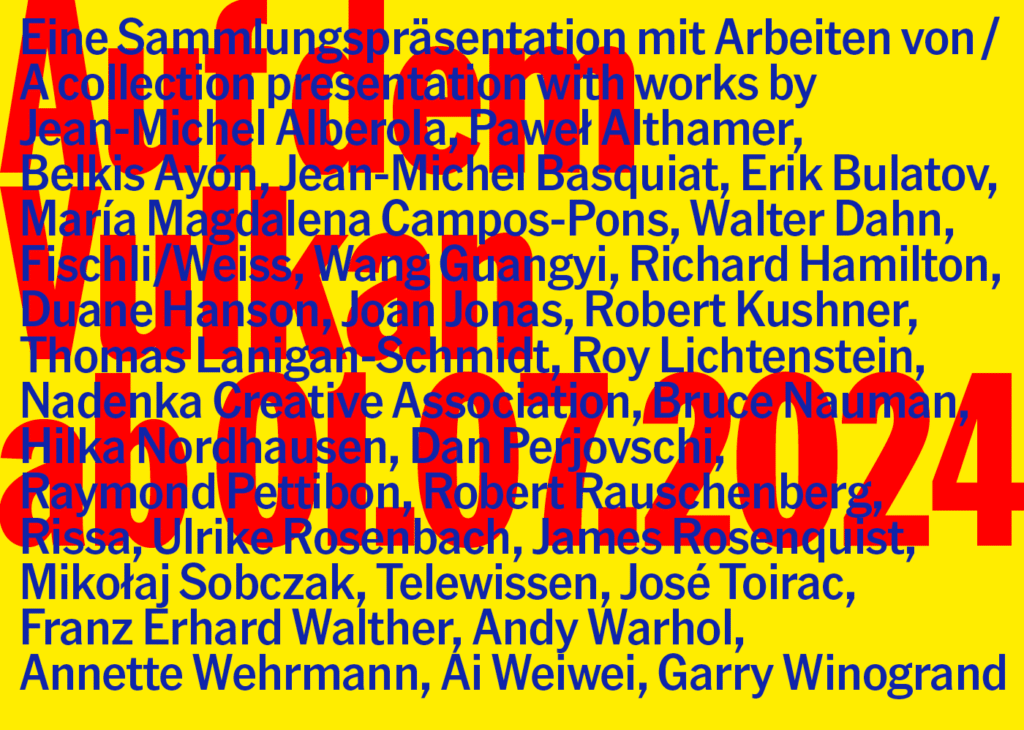A collection presentation with works by Jean-Michel Alberola, Paweł Althamer, Belkis Ayón, Jean-Michel Basquiat, Erik Bulatov, María Magdalena Campos-Pons, Walter Dahn, Fischli/Weiss, Wang Guangyi, Richard Hamilton, Duane Hanson, Joan Jonas, Robert Kushner, Thomas Lanigan-Schmidt, Roy Lichtenstein, Nadenka Creative Association, Bruce Nauman, Hilka Nordhausen, Dan Perjovschi, Raymond Pettibon, Lady Pink (Sandra Fabara), Robert Rauschenberg, Rissa, Ulrike Rosenbach, James Rosenquist, Mikołaj Sobczak, Telewissen, José Toirac, Franz Erhard Walther, Andy Warhol, Annette Wehrmann, Ai Weiwei, Garry Winogrand
Opening: Sunday, June 30, 2024, from 11 am
On the Volcano, the title of the current presentation of works from the Ludwig Forum’s collections, is borrowed from one of Franz Erhard Walther’s “word-pictures,” a device the artist used to open up “spaces of projection” which viewers could then fill, through their own thoughts, with meaning and content. The paraphrased metaphor to “dance on the lip of a volcano” goes back to an observation made by the French statesman and publicist Narcisse-Achille de Salvandy on the eve of the 1830 July Revolution to describe risky, almost naïve behavior in the face of imminent disaster. Relating this imagery to our reappraisal of the collections at the Ludwig Forum enables us to critically plot the crucial upheavals and the conflicts and divisions marking our contemporary age: the current discourses on freedom (of speech and of expression in the arts) and justice irrespective of origin, gender, or class, are the starting point to realign artistic positions within the collections.
The various global manifestations of Pop Art, the artistic direction which brought worldwide renown to the collection of Peter and Irene Ludwig overnight, begins the presentation. After the fall of the Iron Curtain and parallel to the ever-advancing “export” of capitalism, this direction spread to numerous parts of the world. The first room of the exhibition accordingly initiates a dialogue between works by American superstars like Andy Warhol and Roy Lichtenstein with the diverse variations and extensions of Pop Art evident in the creative approaches taken by Erik Bulatov, Ai Weiwei, Hilka Nordhausen, Rissa (Karin Götz), and José Toirac. Garry Winogrand’s photo series Public Relations and Trio Sonata in Video. Deutschland, Deutschland by the artist group telewissen reflect the social upheavals which had begun in the 1960s in Germany and the United States—precisely the point in time Peter and Irene Ludwig started to collect pivotal works of Pop Art and successively expand their burgeoning collection with works by other international artists.
The second room of the exhibition focuses on questions emerging from the politics of representation and visibility beyond entrenched stereotypes. On the one hand, this entails inquiring critically into the presence of and the gaze on the body, while on the other it enables a tracing of transformative strategies of self-determination and the dissolution of gender-specific role models in favor of more fluid ideas of identity. Along with graphic works and paintings by Jean-Michel Alberola, Belkis Ayón, Richard Hamilton, and Robert Kushner, this section will also show video works by Joan Jonas, Bruce Nauman, and Ulrike Rosenbach.
The next room of the exhibition takes up and elaborates on this thread, presenting works by Jean-Michel Basquiat, Fischli/Weiss, Dan Perjovschi, Robert Rauschenberg, Mikołaj Sobczak, and Franz Erhard Walther, which explore surveillance, oppression, exploitation, and racism, while revealing recurrent patterns of violence and resistance.
Finally, On the Volcano is not only concerned with exploring the potential of art to open up spaces for affirmative projections and action, but also seeks to identify the possibilities inscribed in collective and participative forms of artistic practice. Here, Paweł Althamer’s installation in Aachen’s St Elisabeth’s church is exemplary: a playground slide in the form of a pulpit, created in collaboration with children from the neighborhood. In Thomas Lanigan-Schmidt’s Iconostasis, the iconography of Christian and Byzantine churches is converted into a queer aesthetic: combining profane materials, glitzy camp elements and queer motifs with the pictorial tradition of Orthodox Christianity, Lanigan-Schmidt’s altar merges supposedly contrary spheres and thus simultaneously blurs the boundaries between sub, pop, and high culture.
Curated by Eva Birkenstock and Holger Otten
Events
Opening
